Rare 1959 Austin 152 Bluebird Highwayman camper van
Posted by Chris Graham on 3rd May 2024
With summer fast approaching, Mike Neale takes a look at Tony Dymott’s 1959 Austin 152 Bluebird Highwayman – a truly classic camper.
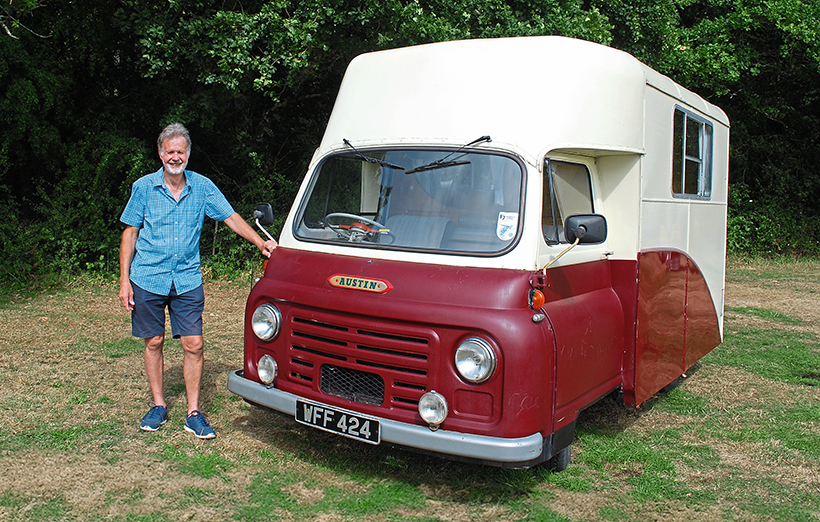
Tony Dymott and his now rare, 1959 Austin 152 Bluebird Highwayman camper van.
The Morris J2 and Austin 152 were launched in June 1956 as a van, pick-up and minibus, or in Austin-speak, ‘Omnivan’, ‘truck’ and ‘coach’. They could also be ordered as a chassis cab for coach-built bodies to be added. The Morris J2 had a tall pear-shaped grille with vertical slots, while the Austin 152 had a lower grille with horizontal slots. Later the Austin version was also called the J2, and the Austin-type grille was standardised on Morris-badged versions as well.
Initially rated at 15cwt, from 1960 they were upgraded to 16/18cwt. They were powered by the 1,489cc B-Series petrol engine and had a column gearchange. That was replaced by a floor-mounted gearchange from 1961, with a ‘backwards’ configuration to catch out the unwary (with the higher gears to the left of the lower ratios). At the same time, a 1,489cc diesel was also offered.

The curved side flash and two-tone paint relieve the otherwise rather boxy appearance. Single rear door allows space either side for a wardrobe and toilet cubicle.
From 1963, the 1,622cc B-Series engine was fitted. Thankfully, from 1965, the gearshift was changed to a conventional H-pattern with the gears ‘the right way round’, so you need to check which type is fitted. Production ended in April 1967 after some 162,000 had been built. Survivors are rare, largely due to this being BMC’s first integral construction commercial vehicle, before they’d properly worked out how to protect the inside of any closed steel box sections from rusting, with only the outside surfaces being sprayed.
Bluebird Caravans Ltd. of Parkstone, Poole, in Dorset, run by Bill Knott was, by the late 1950s, a major manufacturer of both static and touring caravans – ‘The World’s largest caravan organisation’, its advertisements proudly proclaimed.
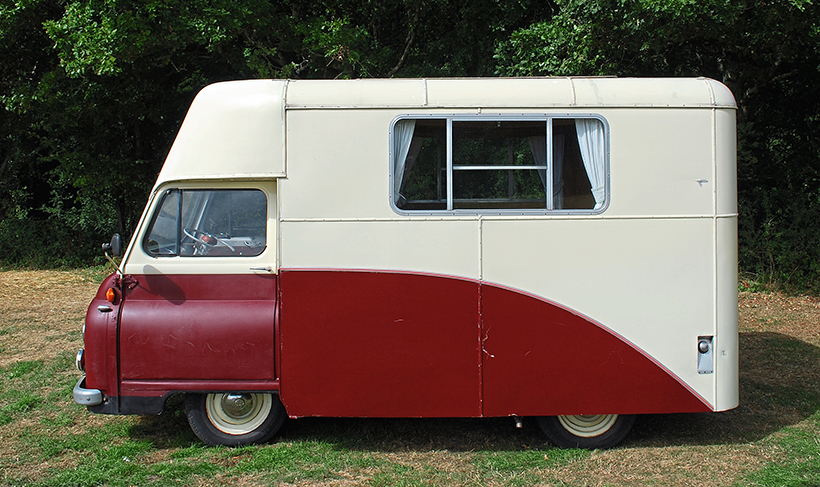
The boxy shape is most apparent from side on.
Bill recognised the potential market for motor caravans and decided to launch a mass-produced coach-built vehicle in 1958 that he named the Bluebird Highwayman. These were initially built only on the Morris J2/Austin 152 chassis and at £870 were at the time the cheapest coach-built motorhome available. For that, however, you didn’t get quite the same high quality of fittings as you did with the Paralanian coach-built BMC J2 motorhomes, which had been launched in 1957 by Central Garage Ltd of Bradford. Early Paralanians looked quite similar to the Highwayman at first glance.
From 1960, the Highwayman was built on the Commer FC1500 (later PA and PB) chassis, which became a best-seller.
The sales blurb extolled the virtues of the J2/152 Highwayman being ‘as manoeuvrable as an ordinary medium sized car (and occupies no more space)’. It went on to claim, perhaps with a smidgeon of hyperbole, that it ‘has a high safe cruising speed (ideal even for continental touring). This is your own luxury hotel, to go with you wherever you go – on business or pleasure’.

Cab, complete with the infamous early J2 column gearchange which was never that precise, even when new!
‘And look at the accommodation! A double bed and two single bunks. Kitchen unit, including hotplate. Room to dine and wine’.
The interior is actually a comfortable place to be. The single rear door allowed for a full-height wardrobe and a toilet compartment fitted with a chemical loo. There was an 11-gallon water tank and 12V electrics.
The boxy but practical rear body design was given some relief with a curving swage line and two-tone colour schemes. The Highwayman was sold in London through Crofton Garages, run by Peter Duff, who had a showroom on the Kings Road in Chelsea, putting it out there among swinging sixties Londoners.
From 1961, Duff was given the agency for the whole of the south of England, then from 1963 all of the country. Later he also tackled the United States after exhibiting the Commer Highwayman at the Californian Sportsman’s Show in 1965. In the US it was named the Sunbeam Funwagen, in which guise it was sold until the late 1960s, where presumably the Sunbeam name was a better-known brand of the Rootes Group than Commer, thanks to the Sunbeam Alpine sports car.
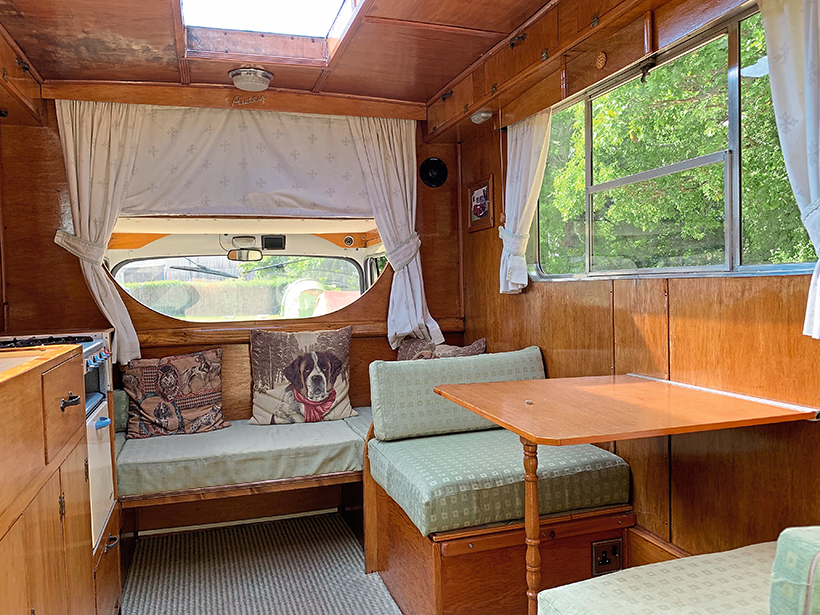
Light and airy interior, though some of the fittings and fixtures reflect the fact that the Bluebird Highwayman was the cheapest coachbuilt motor home of its day.
1960s mergers saw Bluebird Caravans & Motorhomes and Sprite Caravans becoming Caravans International, and from 1973 the firm was renamed CI Autohomes Ltd. The Commer version of the Highwayman was built until 1975, still in Poole in Dorset, after which a completely redesigned Highwayman was sold on the Leyland Sherpa chassis.
Tony’s Highwayman
This Austin 152 Bluebird Highwayman was bought by Tony Dymott in 2016, becoming its 10th owner, and his wife – Janine – named her ‘Fiona’.
Tony already owned an Austin Seven van, but wanted a larger Austin for vehicle shows that they could sleep in. He first looked at a 1920s Austin pick-up that was big enough to sleep in, but then saw this advertised on the internet.
“Janine said that it looked like a horse box, but she fell in love with it!” laughs Tony. The van was in Leatherhead, so Tony caught the ferry over to the mainland from the Isle of Wight where he now lives and got a train up in order to drive it back. This wasn’t entirely without incident.

Seating accommodation, showing how the single central door allows room for things on either side.
“As I was on my way back, I got a phone call from the previous owner, who’d left his computer tablet in the back, so I had to head back and meet him. Then the fuel began vaporising, as it was a really hot day. I ended up taking out the front passenger seat and removing the engine cover, and managed to get it home. I’ve now fitted an auxiliary fan,” explains Tony.
The previous owner had built a garage with an inspection pit to house the vehicle. He had bought it for continental touring, but then decided it wasn’t ideal for it – despite that being what the original advertisements claimed! As the husband, wife and two children used to all camp in the Austin, perhaps it was unsurprising that he decided to put it up for sale. One child would sleep behind the cab while the other had a hammock above the front driver’s and passenger seats. It was less cramped for just Tony and Janine when they used it for camping, which they did in the New Forest quite often.
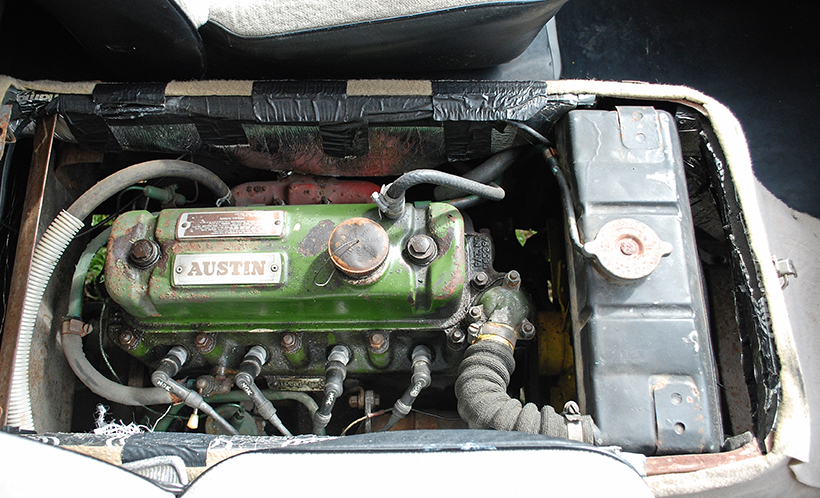
The van still has its original 1,489cc B-Series engine, as fitted to many contemporary BMC cars. A diesel version was an economical but slow and noisy alternative.
“The chap I bought it from had fitted a servo to the brakes and claimed he could hit 60mph in it, but I’m not so sure. It’s happy at about 40-45mph,” Tony tells me. “I like the fact that you can stand up in it without raising the roof, and I love the clear roof panel. There’s a wide area inside, and you don’t feel closed in like on modern camper vans. There are handy little cubby holes tucked in everywhere.”
The van shows 53,000 miles on the clock. It has the original 1,489cc BMC B-Series engine, with the early, column-change gearbox, which Tony describes as imprecise”. When he took it on the first test drive, he kept putting it into 3rd instead of 1st by mistake, but it still pulled away OK. A spare engine came with the van in a “box of bits!”

Fine detail on the light fittings looks almost art-deco!
Tony fitted a new carburettor, kingpins, track rod ends, a fuel pump, starter motor, solenoid and a water pump. “The water pump was making a rattling noise, but it was very difficult to fit – I still have the scars on my hand to prove it!” Tony recalls.
Inside, Tony revarnished the woodwork, but the seats and carpet are believed to be the van’s originals. The original Calor Gas B500 Popular cooker works and is regularly used.
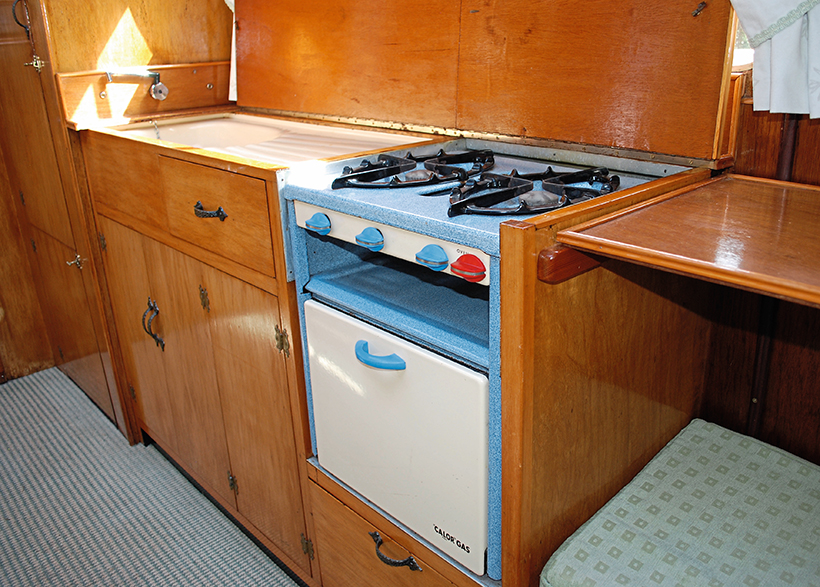
The original Calor gas cooker still works. The hob and sink are below a lift-up flap.
The van has had three different registration numbers, 10 owners (although only nine different ones) and two colour schemes. It was built as a chassis cab in December 1959 and sent to Bluebird for bodying, being painted in green and cream. It was supplied by Motor Delivery Co. Ltd. of Grange Road, Darlington to its first owner, a Dr Anderson from Sunderland, and first registered 1868 HN in July 1960. He kept it until 1986, when it was sold to a scrapyard owner in Sunderland who wanted the registration as it had his daughter’s initials, and it was reregistered WRG 239A.
He sold the van straight on, which went to Bishop Auckland for its next owner who did quite a lot of work to it and used it to tow a barrel organ. The fourth owner towed his Berkeley three-wheel car with it. The owner after that was in Doncaster, after which it went to Hull, then back to Doncaster to the person who had owned it before. The 8th owner was down on the south coast, in Worthing, then the 9th in Leatherhead, and it’s now on the Isle of Wight with Tony. Somewhere along the way, the inappropriate A-reg was replaced by an age-related plate, WFF 424, and the colour was changed to maroon and cream.
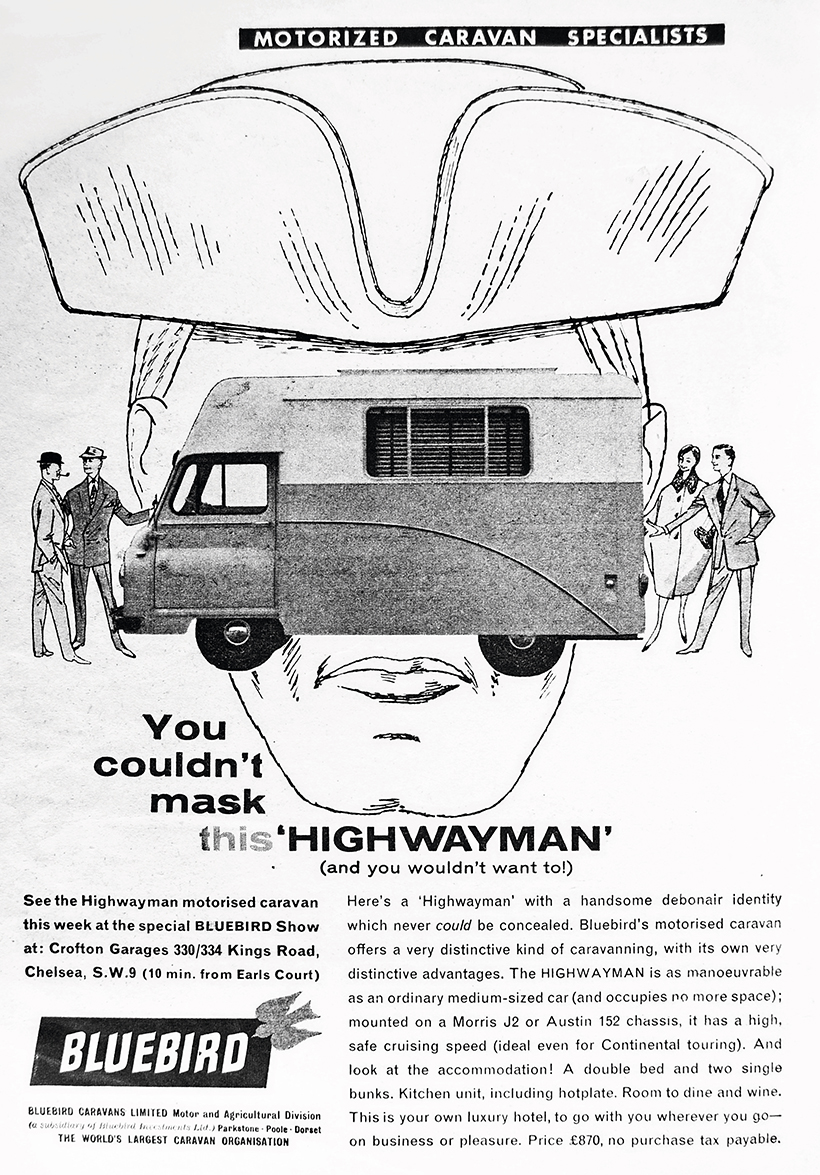
A period advert for the Bluebird Highwayman, dating from 1960.
Sadly, at about the time Tony bought the van, Janine became ill with leukaemia. “She became very stressed about hospitals, but Fiona was the lady that helped her overcome this,” notes Tony. Janine died five years ago, and Tony has now reluctantly decided to sell the van as his new partner has a VW camper, and they don’t need two camper vans.
With thanks to Tony Dymott for taking the time to show me his now rare van. For further reading I recommend Martin Watts’ excellent and detailed book, Classic Camper Vans – The Inside Story, published by Crowood Press in 2007.
This feature comes from the latest issue of Classic & Vintage Commercials, and you can get a money-saving subscription to this magazine simply by clicking HERE
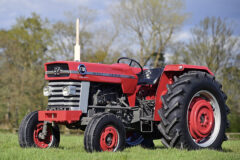
Previous Post
1971 Massey Ferguson 178 painstakingly restored
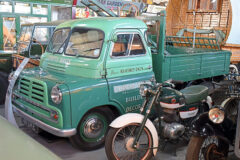
Next Post
The Dover Transport Museum is a fascinating gem!



